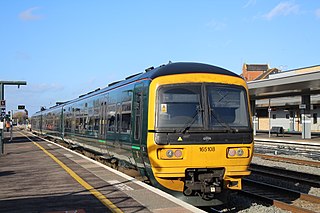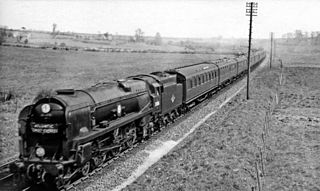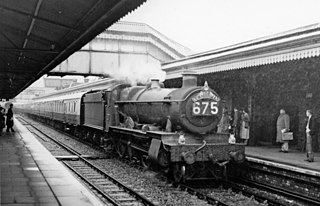
The Great Western Railway (GWR) was a British railway company that linked London with the southwest, west and West Midlands of England and most of Wales. It was founded in 1833, received its enabling act of Parliament on 31 August 1835 and ran its first trains in 1838 with the initial route completed between London and Bristol in 1841. It was engineered by Isambard Kingdom Brunel, who chose a broad gauge of 7 ft —later slightly widened to 7 ft 1⁄4 in —but, from 1854, a series of amalgamations saw it also operate 4 ft 8+1⁄2 in standard-gauge trains; the last broad-gauge services were operated in 1892.

Great Western Railway (GWR) is a British train operating company owned by FirstGroup that operates the Greater Western passenger railway franchise. It manages 197 stations and its trains call at over 270. GWR operates long-distance inter-city services along the Great Western Main Line to and from the West of England and South Wales, inter-city services from London to the West Country via the Reading–Taunton line, and the Night Riviera sleeper service between London and Penzance. It provides outer-suburban services in West London; commuter services from its London terminus at Paddington to the Thames Valley region, including parts of Berkshire and Buckinghamshire, and Oxfordshire; and regional services throughout the West of England and South Wales to the South coast of England. Great Western Railway provides and maintains the Electrostar Class 387 fleet for Heathrow Express.

The British Rail Class 180 is a class of 14 diesel-hydraulic multiple-unit passenger trains manufactured by Alstom at its Washwood Heath factory in 2000/01 for First Great Western (FGW). They are part of the Coradia 1000 family, along with the Class 175.

First Great Western Link (FGWL) was a train operating company in England owned by FirstGroup that operated the Thames franchise from April 2004 until March 2006.

The Blue Pullmans were luxury trains used from 1960 to 1973 by British Rail. They were the first Pullman diesel multiple units, incorporating several novel features.

The British Rail Class 165 Networker Turbo is a fleet of suburban diesel multiple unit passenger trains (DMUs), originally specified by and built for the British Rail Thames and Chiltern Division of Network SouthEast. They were built by BREL York Works between 1990 and 1992. An express version was subsequently built in the form of the Class 166 Networker Turbo Express trains. Both classes are now sometimes referred to as "Networker Turbos", a name derived some three years later for the project that resulted in the visually similar Class 365 and Class 465 EMUs.

Exeter St Davids railway station is the principal railway station serving the city of Exeter in Devon, England. It is 193 miles 72 chains from the zero point at London Paddington, on the line through Bristol which continues to Plymouth and Penzance. It is also served by an alternative route to London Waterloo, via Salisbury, and branch lines to Exmouth, Barnstaple and Okehampton. It is currently managed by Great Western Railway and is served by trains operated by Great Western Railway, South Western Railway and CrossCountry. It is the busiest station in Devon, and the third busiest station in South West England.

Newport is the second-busiest railway station in Wales. It is situated in Newport city centre and 158 miles 50 chains (255.3 km) from London Paddington, via Stroud.

The British Rail Class 43 (HST) is the TOPS classification used for the InterCity 125 High Speed Train (formerly Classes 253 and 254) diesel-electric power cars, built by British Rail Engineering Limited from 1975 to 1982, and in service in the UK since 1976.

The Atlantic Coast Express (ACE) is an express passenger train in England that has operated at various times between London and seaside resorts in the South West England. It is currently operated as a summer only service by Great Western Railway between London Paddington and Newquay.

The Cheltenham Spa Express is a British named passenger train service from Paddington station, in London, to Cheltenham Spa, in Gloucestershire, via Reading, Kemble, Stroud, Stonehouse and Gloucester. During the 1930s, when operated by the Great Western Railway, the service was more popularly known as the Cheltenham Flyer.

The Night Riviera is a sleeper train operated by Great Western Railway (GWR). It is one of only two sleeper services on the railway in the United Kingdom. The Night Riviera runs six nights a week (Sunday–Friday) between London Paddington and Penzance with one train in each direction.

Pullman trains in Great Britain were mainline luxury railway services that operated with first-class coaches and a steward service, provided by the British Pullman Car Company (PCC) from 1874 until 1962, and then by British Railways from 1962 until 1972. Many named mainline service trains have subsequently used the word 'Pullman' in their titles, but most of these have been normal trains with increased first-class accommodation. Since 1982 however, some railtours have been operated by companies using Pullman coaches dating from the 1920s to 1950s to recreate the ambience of the heyday of Pullman travel.

The Cornish Riviera Express is a British express passenger train that has run between London Paddington and Penzance in Cornwall since 1904. Introduced by the Great Western Railway, the name Cornish Riviera Express has been applied to the late morning express train from London to Penzance continuously through nationalisation under British Rail and privatisation under First Great Western, only ceasing briefly during the two World Wars. The name is also applied to the late morning express train running in the opposite direction from Penzance to London. Through performance and publicity the Cornish Riviera Express has become one of the most famous named trains in the United Kingdom and is particularly renowned for the publicity employed by the Great Western Railway in the 1930s which elevated it to iconic status. Today it is operated by the Great Western Railway train operating company.

The Cornishman was a British express passenger train to Penzance in Cornwall. From its inception in the 19th century until before World War II it originated at London Paddington. Under British Railways the name was applied to a different service, starting variously from Wolverhampton, Leeds or Bradford.

The British Rail Class 800, branded as the Intercity Express Train (IET) by Great Western Railway (GWR) and Azuma by London North Eastern Railway (LNER) is a type of bi-mode multiple unit train built by Hitachi Rail for GWR and LNER. The type uses electric motors powered from overhead electric wires for traction, but also has diesel generators to enable trains to operate on unelectrified track. It is a part of the Hitachi AT300 product family.

The British Rail Class 387 Electrostar is a type of electric multiple unit passenger train built by Bombardier Transportation. They are part of the Electrostar family of trains. A total of 107 units were built, with the first train entering service with Thameslink in December 2014. The trains are currently in service with Great Western Railway, Govia Thameslink Railway, and Heathrow Express. The Class 387 is a variation of the Class 379 with dual-voltage capability which allows units to run on 750 V DC third rail, as well as use 25 kV AC OLE. The class were the final rolling stock orders from the Bombardier Electrostar family with 2,805 vehicles built over 18 years between 1999 and 2017.

The British Rail Class 802 is a type of high-speed bi-mode multiple-unit passenger train designed and produced by the Japanese manufacturer Hitachi Rail. It has been operated by Great Western Railway, TransPennine Express, and Hull Trains; each of these train operating companies has given its own units a unique brand: Great Western Railway's units are branded Intercity Express Trains (IETs), TransPennine Express units are branded Nova 1s and Hull Trains' units are branded Paragons.

The Cathedrals Express was a named passenger express introduced in 1957 on the Western Region of British Railways. It connected the cathedral cities of Hereford and Worcester to London Paddington.
The Red Dragon is a named passenger train service operated by Great Western Railway in the United Kingdom from Carmarthen to London Paddington.



















